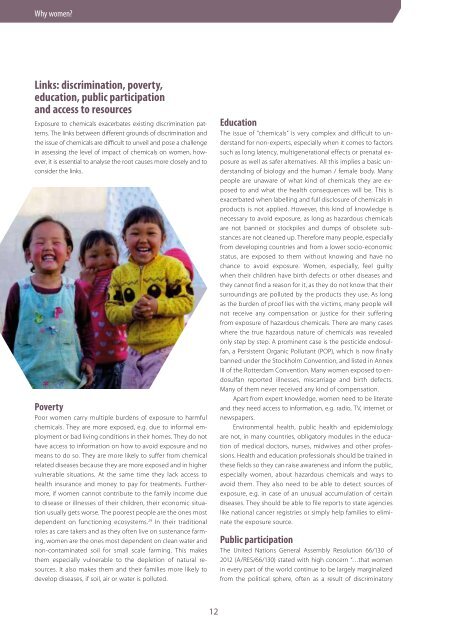Women and Chemicals
1ToENNR
1ToENNR
Create successful ePaper yourself
Turn your PDF publications into a flip-book with our unique Google optimized e-Paper software.
Why women?<br />
Links: discrimination, poverty,<br />
education, public participation<br />
<strong>and</strong> access to resources<br />
Exposure to chemicals exacerbates existing discrimination patterns.<br />
The links between different grounds of discrimination <strong>and</strong><br />
the issue of chemicals are difficult to unveil <strong>and</strong> pose a challenge<br />
in assessing the level of impact of chemicals on women, however,<br />
it is essential to analyse the root causes more closely <strong>and</strong> to<br />
consider the links.<br />
Poverty<br />
Poor women carry multiple burdens of exposure to harmful<br />
chemicals. They are more exposed, e.g. due to informal employment<br />
or bad living conditions in their homes. They do not<br />
have access to information on how to avoid exposure <strong>and</strong> no<br />
means to do so. They are more likely to suffer from chemical<br />
related diseases because they are more exposed <strong>and</strong> in higher<br />
vulnerable situations. At the same time they lack access to<br />
health insurance <strong>and</strong> money to pay for treatments. Furthermore,<br />
if women cannot contribute to the family income due<br />
to disease or illnesses of their children, their economic situation<br />
usually gets worse. The poorest people are the ones most<br />
dependent on functioning ecosystems. 29 In their traditional<br />
roles as care takers <strong>and</strong> as they often live on sustenance farming,<br />
women are the ones most dependent on clean water <strong>and</strong><br />
non-contaminated soil for small scale farming. This makes<br />
them especially vulnerable to the depletion of natural resources.<br />
It also makes them <strong>and</strong> their families more likely to<br />
develop diseases, if soil, air or water is polluted.<br />
Education<br />
The issue of “chemicals” is very complex <strong>and</strong> difficult to underst<strong>and</strong><br />
for non-experts, especially when it comes to factors<br />
such as long latency, multigenerational effects or prenatal exposure<br />
as well as safer alternatives. All this implies a basic underst<strong>and</strong>ing<br />
of biology <strong>and</strong> the human / female body. Many<br />
people are unaware of what kind of chemicals they are exposed<br />
to <strong>and</strong> what the health consequences will be. This is<br />
exacerbated when labelling <strong>and</strong> full disclosure of chemicals in<br />
products is not applied. However, this kind of knowledge is<br />
necessary to avoid exposure, as long as hazardous chemicals<br />
are not banned or stockpiles <strong>and</strong> dumps of obsolete substances<br />
are not cleaned up. Therefore many people, especially<br />
from developing countries <strong>and</strong> from a lower socio-economic<br />
status, are exposed to them without knowing <strong>and</strong> have no<br />
chance to avoid exposure. <strong>Women</strong>, especially, feel guilty<br />
when their children have birth defects or other diseases <strong>and</strong><br />
they cannot find a reason for it, as they do not know that their<br />
surroundings are polluted by the products they use. As long<br />
as the burden of proof lies with the victims, many people will<br />
not receive any compensation or justice for their suffering<br />
from exposure of hazardous chemicals. There are many cases<br />
where the true hazardous nature of chemicals was revealed<br />
only step by step. A prominent case is the pesticide endosulfan,<br />
a Persistent Organic Pollutant (POP), which is now finally<br />
banned under the Stockholm Convention, <strong>and</strong> listed in Annex<br />
III of the Rotterdam Convention. Many women exposed to endosulfan<br />
reported illnesses, miscarriage <strong>and</strong> birth defects.<br />
Many of them never received any kind of compensation.<br />
Apart from expert knowledge, women need to be literate<br />
<strong>and</strong> they need access to information, e.g. radio, TV, internet or<br />
newspapers.<br />
Environmental health, public health <strong>and</strong> epidemiology<br />
are not, in many countries, obligatory modules in the education<br />
of medical doctors, nurses, midwives <strong>and</strong> other professions.<br />
Health <strong>and</strong> education professionals should be trained in<br />
these fields so they can raise awareness <strong>and</strong> inform the public,<br />
especially women, about hazardous chemicals <strong>and</strong> ways to<br />
avoid them. They also need to be able to detect sources of<br />
exposure, e.g. in case of an unusual accumulation of certain<br />
diseases. They should be able to file reports to state agencies<br />
like national cancer registries or simply help families to eliminate<br />
the exposure source.<br />
Public participation<br />
The United Nations General Assembly Resolution 66/130 of<br />
2012 (A/RES/66/130) stated with high concern “…that women<br />
in every part of the world continue to be largely marginalized<br />
from the political sphere, often as a result of discriminatory<br />
12


